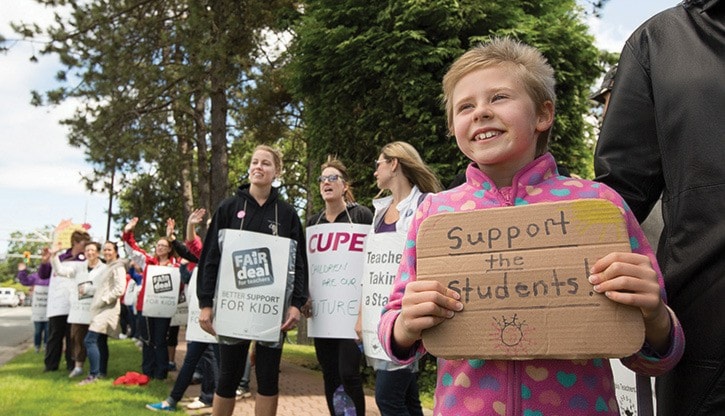Hundreds of Sooke School District teachers and their supporters lined Veteran’s Memorial Parkway this week on the first day of a series of rotating strikes around the province.
Stage 2 of a three-stage plan from the B.C. Teachers Federation went into action Monday in response to slowed negotiations with the government on a new deal.
Coming into effect the same day was a lockout that prevents teachers from coming in earlier than 45 minutes before the first class, or staying 45 minutes after the last class.
Paul Waterlander, a BCTF vice-president and a half-time history teacher at Belmont secondary, said teachers feel they don’t have much of a choice on whether to strike or not.
“The government has all the cards here, they are the ones that create the bargaining structure. We have said the structure has been faulty for a long time, but they have yet to move it,” he said.
“What the teachers are doing is reactive. We can’t tell the government how the bargaining should look, it is something that they have to address.”
Waterlander held firm that salaries, class sizes, and support for special needs students are important factors in the negotiations.
Monday’s show of solidarity saw upwards of 300 of the 650 to 750 contract and non-contract teachers in the Sooke School District take part.
“Today we are showing the public and province the way public education is going right now is not the way it should be going,” said music teacher Maureen Garry.
“We have found over the years the services we can provide are less and less because there is less funding for special needs students, there are less teachers and the job gets harder and harder.”
Standing outside David Cameron elementary in Langford, where she has taught for seven years, Garry said the last thing she wanted was to be standing at the curb with a sign hanging on her neck, instead of being inside teaching her students.
“It is really unfortunate we have gotten to this point, but when things are quiet in the schools, nobody pays much attention until there is some sort of disruption,” she said.
“We have tried to make it peaceful for the students studying in our school.”
Board of education chair Wendy Hobbs said the board is in the process of sending a letter to the government to ask for a negotiated settlement, but that is easier said than done. She hopes a settlement is forthcoming, with teachers back in the classrooms full time and students back at their desks.
“We want our kids to get back to school,” she said. “We don’t want to see rotating strikes affect field trips. Who it is really hurting is the children.”
Education Minister Peter Fassbender said no legislation is planned to end the teacher strike and the government won’t be imposing any contract extensions on the union.
Stage 2 comes on the heels of teachers refusal to do certain administrative duties and child supervision in stage 1. Stage 3 would be a full-scale walkout by all teachers in the union, but such a move must be approved by the union members first. That vote has not yet happened.
“The toughest part for me is watching a government pretend to bargain, but not really, which creates this crisis,” Waterlander said. “Which forces us to walk out on our jobs and leave the students that we are teaching, and that is really hard.”
alim@vicnews.com
